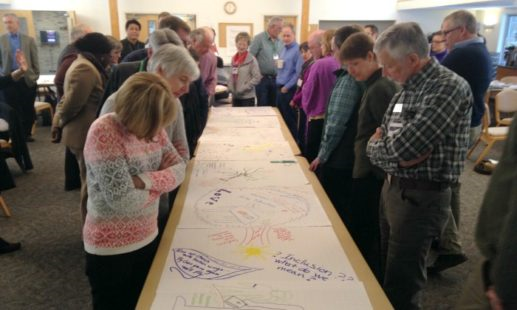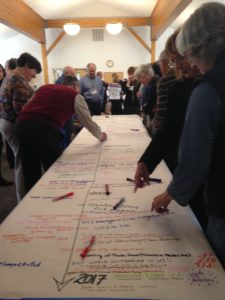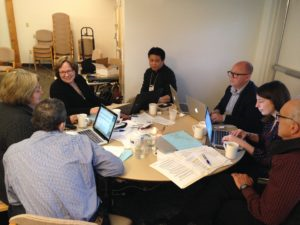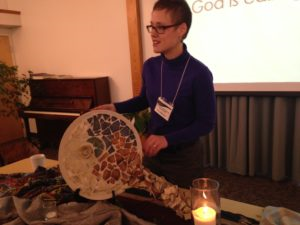Note: This article first appeared in The Mennonite.
By Hannah Heinzekehr
ELKHART, Indiana (Mennonite Church USA) Eschewing their usual agenda, members of the Constituency Leaders Council (CLC) spent their last meeting of the biennium testing a large-group visioning process that will be used at the Mennonite Church USA Convention in Orlando this July.

Members of the Constituency Leaders Council view visioning posters created by table groups during their March 16-18 meetings in Elkhart, Indiana. Photo by Hannah Heinzekehr.
Around 70 attendees, representing area conferences, constituency groups and agencies of Mennonite Church USA met March 16-18 on the campus of Anabaptist Mennonite Biblical Seminary in Elkhart, Indiana.
CLC worship coordinators Jane Hoober Peifer, Harrisonburg, Virginia, and Michael Zehr, Key West, Florida, opened the meetings with singing and a Scripture-based meditation on the theme of trust.
Peifer noted that for many it feels that trust across Mennonite Church USA and between conferences is low. She noted that a study of the use of the word “trust” in Scripture reveals that trust has a positive association when used to refer to trust in God, but that it is often used negatively to describe trust placed in other places, including the sword, other people, money and more.
“God does not need us to trust each other,” she said. “God needs us to trust God and love each other. The Lord is our rock and our refuge.”
Participants were invited to share Communion with one another and place a candle at the center of their tables, representing Christ’s presence.
Following worship, CLC members dove into a visioning process. The goal was to invite participants to reflect on the question, “How will we follow Jesus as Anabaptists in the 21st century?” In addition, the large group process invited participants to collaborate in order to identify priorities for CLC’s work over the next biennium.

CLC Participants co-created a timeline of historical events for Mennonites and in the world over the last 100 years. Photo by Hannah Heinzekehr.
Catherine Barnes of Eastern Mennonite University’s Center for Justice and Peacebuilding, Harrisonburg, Virginia, served as the facilitator for all visioning sessions.
“Where is God leading you as a church?” said Barnes, in her introduction to the process. “Are you heading where you want to go?”
By the end of the meeting, the group had identified four priorities to guide its work going forward as well as a host of ideas about how to tackle the work. The priorities, discerned and then voted on by participants, included the following:
- Equipping and resourcing each other (and conferences and constituency groups) with skills for addressing practical issues facing the future of the organizational church. The group especially highlighted immigration, creation care, financial sustainability and sexual abuse prevention as key areas for resourcing.
- Building a culture of trust at CLC.
- Making sure there is diversity and equitable representation at CLC, taking into account people of color, gender and age.
- Grounding the work of the CLC in the movement of the Holy Spirit.
CLC members spoke into these priorities through several exercises, including constructing a timeline of key Mennonite and world events from the past 100 years, participating in table group and plenary conversations, worship, guided meditations, structured group conversations and “World Café” brainstorming conversations.
CLC participants reflected on experiences, both past and present, of struggle to collaborate across conferences and live into a vision of being church together. The process of developing a timeline invited participants to reflect on patterns of splits over theological differences, as well as periods of coming together across the church in order to respond to urgent crises.
In response to questions about how the Mennonite church has historically handled conflict, Dan Miller, Indiana-Michigan Mennonite Conference minister, said, “The way we handle conflict is in a sense a failure to live out our most precious ideals of Christ-centered reconciliation and community. That’s hard to deal with. We can come together along some lines and then split along others.”
Lupe Aguilar, representing South Central Conference, said, “Peace is not the absence of war but the presence of Christ in our lives. Eventually the church will be one again.”
During each session, a theme team, composed of members of the CLC leadership team, as well as members of the Future Church Summit (FCS) design team, collected responses submitted by table groups via iPads and summarized key themes that emerged. Members of the theme team included Ken Burkholder, Luke Gascho, Iris de Leon- Hartshorn, Hyun Hur, Janie Beck Kreider ( all members of the design team) and Katherine Jameson Pitts (CLC leadership team).

Members of the “theme team” (clockwise from bottom left): Ken Burkholder, Iris de Leon Hartshorn, Katherine Jameson Pitts, Hyun Hur, Todd Erickson, Janie Beck Kreider and Luke Gascho. Photo by Hannah Heinzekehr.
The FCS design team plans to take the feedback gleaned from this test process to help refine this summer’s process. MC USA leaders are anticipating that 1,000 people, including delegates from across the church, as well as additional participants representing underrepresented groups, will participate in the FCS process July 6-8.
Throughout the CLC process, concerns were raised about the lack of racial-ethnic diversity present in the room.
Grace Pam, representing the African, Belizean, Caribbean Mennonite Mission Association, named this reality and encouraged the CLC and the FCS design team not to rely on popular voting methods to make decisions. “We still don’t have the whole church represented here,” said Pam. “As a church, how do we view all of what we are going through and make sure we do not have the most populous and powerful voting against those whose voices aren’t here.”
Glen Guyton, chief operating officer for Mennonite Church USA and the instigator of this new conversation model, emphasized that the FCS team is actively working to ensure that there will be broad diversity and representation from marginalized groups in Orlando, including people of color, socioeconomic diversity, gender balance, LGBTQ individuals and youth and young adults from across the church.
Overall, Guyton felt positive about the CLC test process and was grateful for feedback that will help improve the conversation model in Orlando.
“Conference leaders are at the heart of our institution and our church,” said Guyton. “If they’re on board with the process, then I think this process has a good chance of succeeding and giving us renewed trust and a clear direction for the church.”
At break times, many CLC participants reflected a new sense of hope and excitement for where this visioning process might be leading the church.
“It seems clear to me there is a new way opening,” said David Boshart, Mennonite Church USA moderator-elect and chair of the CLC. “Let’s be thankful to God for opening that way.”
“A beautiful mess”
Jessica Schrock Ringenberg, representing Ohio Conference of Mennonite Church USA, created an artistic mosaic that was displayed at the front of the room throughout the CLC meetings. At the October 2016 CLC meeting, Schrock

Jessica Schrock Ringenberg shares with her artwork. Photo by Hannah Heinzekehr.
Ringenberg and a group of young adults invited CLC participants to take a shard of pottery representing their hopes and dreams for the church and lay those hopes and dreams down as a sign of trust in one another and creating a new vision together.
Schrock Ringenberg took the pieces and created a circular mosaic, but found that—after the creation had come together—she was left with many extra pieces. She noted that she was tempted to just leave out some of the pieces for the sake of the developing artwork.
“We have this beautiful picture in our head, but we never know what to do with all these ‘inconvenient’ pieces, but they are still somebody’s hopes and dreams,” she said to the group.
In the end, Schrock-Ringenberg used the extra pieces to create a stream or a flow of pieces extending out of (or into) the circle. “The brokenness can either pour into the church or pour out of it,” she said. “What kind of church do we want to be? How do we hold this beautiful mess?”
Learn more about the Future Church Summit at http://convention.mennoniteusa.org/future-church-summit/.

